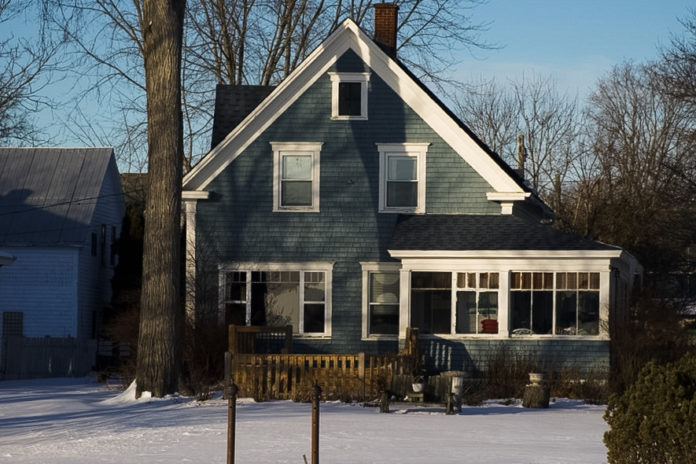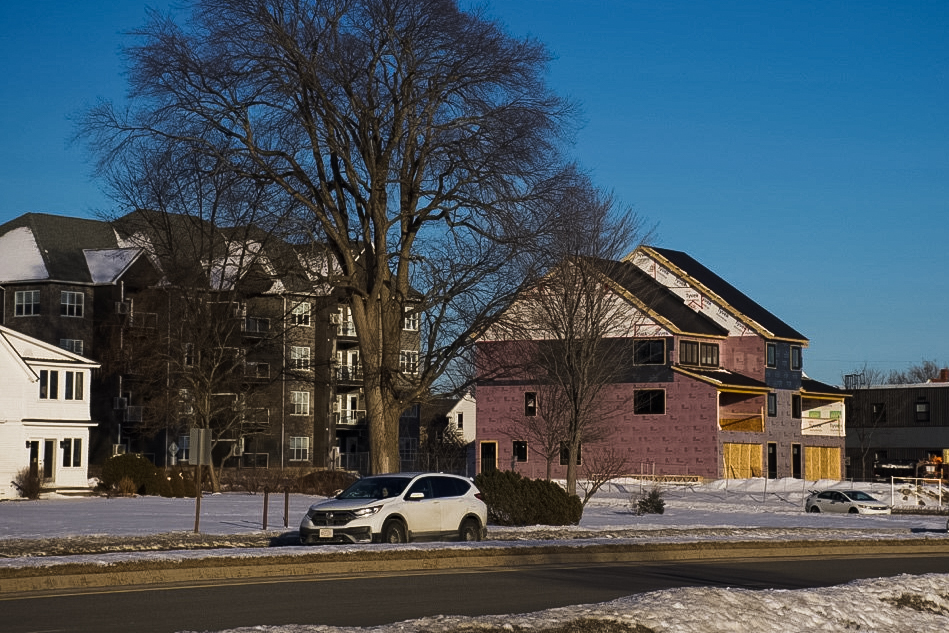

When driving off the Westmorland Street bridge, along Devonshire Drive, there are two posts in front of a blue house on the left. These posts mark where the riverbank was before the Westmorland Street bridge was built. Kathi Vaughan Zwicker grew up in this home in the community of St. Mary’s Ferry Landing.
“There was always a great big place over the bank to play,” said Zwicker. “It was like a little forest with trees and bushes and shrubs and rocks and we were actually playing on the riverbed.”
Today, the neighbourhood where Zwicker grew up has changed. New, more expensive apartments are being built and old homes are being torn down. Now Zwicker and the St. Mary’s Ferry Landing Neighbourhood Association are fighting to keep the community alive.
Part of Fredericton’s north side, the forgotten town of St. Mary’s Ferry, sometimes known as North Devon, occupies the space between Westmorland and Cliff Street and is sandwiched between the two walking trails.
St. Mary’s Ferry was born from the river, built around the ferry landing for passengers heading from St. Mary’s to the market in Phoenix Square, the current site of City Hall.
There was no bridge in Fredericton before 1885. In the winter, the Wolastoq froze and formed an ice bridge. In the summer, Frederictonians relied on ferries.
The first ferries were powered by horses that ran on what is best described as treadmills. These were replaced by steam-powered ferries. Vendors would make their way to town for the Phoenix Square market and would spend the night in St. Mary’s Ferry. Businesses built up around the landing.
Ferry service ended in 1885 when the first bridge opened. The bridge was a campaign promise of Premier Andrew Blair. When the wooden bridge first opened, Frederictonians had little faith in the structure and many continued to cross the frozen river in the winter. The bridge was nicknamed “Blair’s paper bridge” since many believed it would crumple like paper in the spring freshet.
The bridge travelled into the St. Mary’s Ferry onto Cliff Street. The town continued to grow with businesses opening that catered to Frederictonians across the river.
Notable businesses included the St. Mary’s Department Store and St. Mary’s Soap Factory, where every bar was inscribed with “Fredericton Soap.” The factory was later converted into a taxidermy shop. Often, businesses would be a storefront on the bottom floor and a family home on the top two.

It was not a flood but a fire that destroyed the paper bridge. A forgotten cigar on the wooden structure sealed its fate in 1905. Construction began immediately on the second bridge, this time made of steel. The second bridge remained until the 1980s and continued to direct traffic to the landing.
This is how Zwicker remembers the community. She remembers the businesses, especially Bowlen’s Store.
“If a neighbourhood child said we need bread, they would write down that we bought a loaf of bread. Then at the end of the week, when people got paid, they would come over and pay the Bowlen’s.”
She also remembers an enormous block of cheese that was always on the counter and how the tampons were locked away. The floorboards inside Bowlen’s were so worn that there were pathways in between the aisles.
In the summer, the water would descend and the kids would play on the riverbed. In the winter, they would slide down the bank and curl and skate on the ice.
In the spring, there was flooding. Front yards would be submerged and stone basements would fill with water. Zwicker said they would all clean their basements with bleach after the floods — it was part of life.
The spring also meant fiddleheading. Zwicker remembers the Wolastoqiyik from St. Mary’s First Nation preparing for the harvest. The Wolastoqiyik would lay out their canoes the day before and early in the morning, they would paddle off.
“In the evening, all the children and the mothers from St. Mary’s First Nation would come, we would play games in the front yard, waiting for the canoes to come back.”
By the ’80s, Fredericton had grown and the old two-lane bridge was no longer large enough. Both sides of the river had been one municipality for 40 years. St. Mary’s Ferry became part of Devon in 1917. Construction on a new bridge began and shortly after its completion, the Carleton Street bridge was removed.
The Westmorland Street Bridge changed the community and its topography. The riverbank was built up to accommodate the bridge. The trees along the bank were cut down and replaced with a grassy green. River access was cut off by traffic. The traffic went straight over and past the landing.


The community was hidden in the shadow of the bridge, secluded from the rest of the city. There were fights on the streets. The once-family homes became drug houses.
“There were men heaving out of the second store windows, vomiting on the front lawns. It was awful, and I was really scared to live there,” said Zwicker. “As a single mom, I couldn’t raise three kids in that neighbourhood.”
Zwicker left the community and the north side with her children to live in her grandparents’ old house on Charlotte Street.
In 1995, Zwicker’s mother passed away. Her brother Rodney Vaughan returned to St. Mary’s Ferry after 22 years to live in the family home. After seeing what had become of the community where he grew up, Vaughan decided to start a neighbourhood association. He went door-to-door and put flyers in 60 mailboxes. He expected five or six people to show up, but there were over 30.
Their first project was to clean up the drug houses. The association convinced two landlords to remove their tenants. The association bought a third drug house from a landlord and renovated it.
A Telegraph-Journal article at the time described the house as being filled with “urine-soaked mattresses,” garbage and littered with needles.
The neighbourhood association convinced the city to remove the rubble of an old burnt-down garage. The association stood around the rubble and cheered as it was removed.
For five years, Vaughan and the neighbourhood association worked to restore the community. He and the association were recognized by the city council for the changes they brought to St. Mary’s Ferry.
Vaughan passed away from cancer in 2000. By that point, much of the work had been done. The association became his legacy.
“It wasn’t before he had done amazing things and got the streets paved. The list of accomplishments in a very short period of time of the St. Mary’s neighbourhood association is amazing,” said Zwicker about her brother.
The association tried to carry on without Vaughan but without his direction and persistence, it slowly fell apart.
About four years ago, Zwicker returned to the St. Mary’s Ferry. She also noticed a change in the community developments. Despite flooding concerns, new structures were being built on the green and heritage homes were being torn down to be replaced with apartments.
“The new apartments are in excess of $2,000 a month. And so, some people would be going from [$600, $700] and $800 a month to $2,000. There’s no way they could live here. And so, it’s going to change the neighbourhood.”


Zwicker reformed the neighbourhood association. They are working to maintain the character and heritage of St. Mary’s Ferry while trying to create a renewed sense of community. They hope the neighbourhood can continue to be more than a development site.
The association hopes to build community gardens, a speakers’ corner and some smaller shops, like what would have been in the neighbourhood in the days of the ferry. New life already seems to be coming to the community.
“There is some renovation happening in one of the older houses on St. Mary’s Street. I believe it’s going to be an Airbnb. And plus, we hear a coffee shop and maybe some sort of hairdressing esthetics place might come — so we’re excited about that.”


A dream for Zwicker and the community would be a second walking bridge on the old Carleton Street bridge piers. A second walking bridge would make up for the less-than-welcoming walkway on the Westmorland Street bridge and could funnel cyclists and walkers into the community.


Zwicker says she does not see this project happening for several years. It would be a poetic bookend or a “ferry” tale ending: A community born from the river, devastated by a bridge, brought back to life by the neighbourhood and, maybe someday, reinvigorated by a new old bridge.
